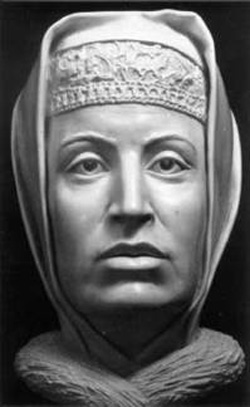History of Russia
Heads of the stateGrand Prince Ivan III Vasilyevich of Moscow and All Rus (1440 - 1505)
Reign 1462-1505
 Parents:
Parents: Grand Prince Basil II Vasilyevich the Dark and Grand princess Maria Yaroslavna (granddaughter of Prince Vladimir Andreyevich the Brave).
Wives:
Maria Borisovna Tverskaya. They were married when Ivan was twelve and Maria was ten. Died on 22 April 1467. According to rumours, she was poisoned.
Zoe (Sophie Fominichna) Paleologus. Niece of the last Byzantine emperor/ Married Ivan on 12 November 1472 and died on 7 April 1503.
Children of Ivan III and Maria Tverskaya:
Ivan the Younger was born on 15 February 1458. From 1471, several documents call him "grand prince", alongside his father. He died in suspicious circumstances at the age of thirty-two (7 March 1490). Married Elena, daughter of Stefan III the Grat, hospodar of Moldova (6 January 1483), who was crowner grand prince in the cap and shoulder mantle of Monomachus at the Dormition Cathedral (4 February 1498). The second wife of Ivan III, Zoe Paleologus, intrigued against Dmitry. Ivan III forbade Dmitry's name to be remembered in the liturgical prayers (11 April 1502) and crowned his second son as Grand Prince Basil III of Moscow (14 April 1502).
 Children of Ivan III and Zoe Paleologus:
Children of Ivan III and Zoe Paleologus:The first two children died in infancy.
Basil (see Basil III)
Yury was born on 23 March 1480 and died in 1536.
Dmitry was born on 6 October 1481 and died in 1521.
Simeon was born on 21 March 1487 and died in 1518.
Andrei was born on 5 August 1490 and died in 1537.
Elena was born on 8 April 1484 and died in 1513. Married the future King Alexander the Jagiellonian of Poland (15 February 1495).
Feodosia was born on 29 May 1485 and died in 1501. Married Prince Vasily Danilovich Kholmsky (1500)
Eudokia was born in 1492 and died in 1513. Married a Tatar pince who converted to Christianity and took the name of Peter (25 January 1506).
Important events:
- 1471 - First war between Moscow and Novgorod. Under the terms of the peace treaty. Novgorod breaks away from Lithuania and recognises the authority of Moscow.
- 1478 - Second war between Moscow and Novgorod. Ivan III annexes Novgorod and removes the veche bell to Moscow.
- 1480 - Stand off with Khan Akhmat at the River Ugra, finally overthrowing the Tatar-Mongol yoke.
- 1485 - Annexation of Tver.
- 1489 - Annexation of Vyatka.
- 1492 - Construction of fortress at the town of Narva called Ivanogorod ("Ivan's town") to halt the aggression of the Livonian Germans.
- 1494 - Lithuania recognises Moscow's right to Novgorod.
- 1497 - Peasants are allowed to leave their owner's in the fortnight before and after St George's First codex of laws.

......1462 - 1505 Moscow rose from the main town of the Muscovite princedom to become the capital of the whole of Russia. Ivan built stone walls and mighty towers around the Kremlin. He invited Italian architect Aristotle Fioravanti to build a five-cupola church inside the Kremlin - the Dormition Cathedral. The Place of Facets and a large stone palace were also constructed.
......1497 In 1497, Ivan III established the official symbol of Russia - a double-headed eagle - which remained the national emblem until October 1917, when the Bolsheviks seized power. On 8 December 2000, the State Duma returned the two-headed eagle to the Russian coat of arms.
Ivan III was tall and slim. Because of a slight stoop, he was known as "Ivan Gorbaty" or "Hunchback". Although handsome, he had a stern gaze, often causing women t faint when he stared at them. Ivan was cautious, slow and calculating in affairs of state. Anything begun was taken to its logical conclusion. Daring and courage were not encouraged. Pity was not part of his character.
During the reign of Grand Prince Ivan III, Moscow increased five times in size/ When he ascended the throne, he ruled over 400,000 square kilometers; by the time he died, his domains exceeded two million square kilometers. Ivan annexed Yaroslavl in 1468, Perm in 1472. Rostov in 1474, Novgorod in 1478, Tver in 1485 and Vyatka in 1489. Many west Russian lands broke away from Lithuania in 1503 to become part of Muscovite Rus. The annexations of Novgorod, Vyatka and Perm - home to non-Russian peoples - created a multi-national state. Before he died, Ivan III divided his territory between his five son, awarding Basil III seniority and sixty-six towns. The four younger son were given a smalled number of towns and forbidden to strike their own coins or enter into diplomatic relations with other nations. Russian historian Nikolai Karamazin wrote about Ivan III: "He left a remarkably large state, with a strong people and a strong power base". In 1476, Ivan III refused to pay tribute to Khan Akhmat of the Grand Horde. Akhmat gathered an enormous army and marched on Rus. The two sides met at the River Ugra, the source of the River Oka, In 1480. Both armies stood on opposite sides of the river, neither side daring to make the first move, remaining there throughout the autumn. Suffering from cold and hunger, the Tatars decided to retreat on 11 November. This event became know as the "great stand-off on the River Ugra". In 1481, Prince Ivak of the Nogai Horde killed Khan Akhmat of the Grand Horde and the hold of the Tatar-Mongol forces crumbled.
Under Ivan III, the prince of Moscow became known as the "grand prince of all Rus". In the dealings with Lithuania and the German kingdoms, the prince was the "tsar of all Rus"/ When addressing their rules, the boyars called him "Ivan Vasilyevich, Sovereign and Grand Prince of all Rus". Ivan III introduced the coronation ceremony, first performed on his grandson Dmitriy, when the metropolitan called Ivan the "tsar" and "autocrat".
recommended
sites:
 Internet shop
of excusive Russian souvenires "ATAMAN".
Internet shop
of excusive Russian souvenires "ATAMAN".
If you want to present a spesial gift to your relatives or friends,
want to get really unforgettable memory about your trip or you are
interested in the history of russia - this shop is a real find for you
There are history maps, books, souvenires, insignia, heraldry and many
other things on this site. This site have the English version.
You can find the link for it in the right top corner of the site
We hope that the information of our portal will be useful to you.
